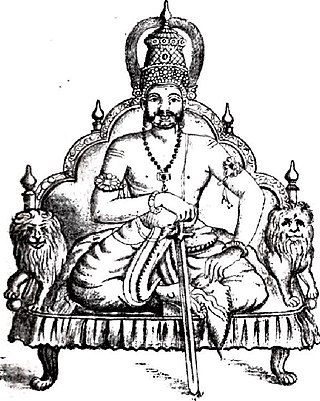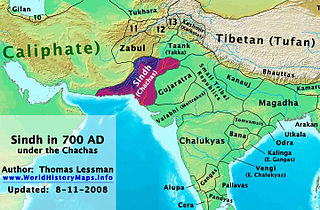Related Research Articles

The Mahājanapadas were sixteen kingdoms and aristocratic republics that existed in ancient India from the sixth to fourth centuries BCE, during the second urbanisation period.

Madra was an ancient Indo-Aryan tribe of north-western South Asia whose existence is attested since the Iron Age. The members of the Madra tribe were called the Madrakas.
Asi appears as a personification of the first weapon ever created according to Hindu epics. 'Asi' means 'sword'. A legend concerning Asi appears in the Shanti Parva book of the Mahabharata. In Rigvedic Sanskrit, Asi is still used as a term for a kind of sacrificial dagger or knife.

Yayati is an emperor in Hindu tradition. He is described to be a Chandravamsha king. He is regarded to be the progenitor of the races of the Yadavas and the Pandavas.

Parīkṣit was a Kuru king who reigned during the Middle Vedic period. Along with his son and successor, Janamejaya, he played a decisive role in the consolidation of the Kuru state, the arrangement of Vedic hymns into collections, and the development of the orthodox srauta ritual, transforming the Kuru realm into the dominant political and cultural center of northern Iron Age India. He also appears as a figure in later legends and traditions. According to the legendary accounts in Mahabharata and the Puranas, he succeeded his grand uncle Yudhishthira to the throne of Hastinapur.

Kekaya was an ancient Indo-Aryan tribe of north-western South Asia whose existence is attested during the Iron Age. The members of the Kekaya tribe were called the Kaikayas.
Janamejaya was a Kuru king who reigned during the Middle Vedic period. Along with his father and predecessor Parikshit, he played a decisive role in the consolidation of the Kuru state, the arrangement of Vedic hymns into collections, and the development of the orthodox srauta ritual, transforming the Kuru realm into the dominant political and cultural part of northern India. He also appears as a figure in later legends and traditions, the Mahabharata and the Puranas.
Madra kingdom was a kingdom grouped among the western kingdoms in the ancient Indian epic Mahabharata. Its capital was Sagala in the Madra region. The Kuru king Pandu's (Pāṇḍu) second wife was from Madra kingdom and was called Madri. The Pandava twins, Nakula and Sahadeva, were her sons. Madri's brother Shalya was the king of Madra. Though affectionate to the Pandavas, he was tricked to give support to Duryodhana and fought against the Pandavas during the Kurukshetra War. He was killed by Yudhishthira, the eldest Pandava. Other than the Madra kingdom with Sagala as its capital, it is believed that there was a Western Madra and a Northern Madra.

Sindhu kingdom or simply Sindhu was an ancient kingdom on the Indian subcontinent. It stretched the banks of river Sindhu (Indus). It was mentioned in the epic Mahabharata and in the Harivamsa Purana, often alongside the Sauvira kingdom. It is believed that Sindhu kingdom was founded by Vrishadarbha, one of sons of Sivi. According to the Glimpses of Ancient Sindh, authored by Mirchandani, its capital was known as Vrsadarbhpura, and Tulsianis, later known as Sindhu, was located at or near the location of the present town of Mithankot the inhabitants of the kingdoms were called Sindhus or Saindhavas. "Sindhu" literally means "river" and "sea". According to the epic Mahabharata, Jayadratha was the king of Sindhus, Sauviras and Sivis. Probably Sauvira and Sivi were two kingdoms close to the Sindhu kingdom and Jayadratha conquered them, holding them for some period of time. Sindhu and Sauvira seem to have been two warring states fighting each other.
Sauvīra was an ancient kingdom of the lower Indus Valley mentioned in the Late Vedic and early Buddhist literature and the Hindu epic Mahabharata. It is often mentioned alongside the Sindhu kingdom. Its capital city was Roruka, identified with present-day Aror/Rohri in Sindh, mentioned in the Buddhist literature as a major trading center. According to the Mahabharata, Jayadratha was the king of the Sindhus, Sauviras and Sivis, having conquered Sauvira and Sivi, two kingdoms close to the Sindhu kingdom. Jayadratha was an ally of Duryodhana and the husband of Duryodhana's sister Dussala. The kingdom of Sauvira is also stated to be close to the Dwaraka and Anarta kingdoms. According to Bhagwat Puran Sauviras were once connected with Abhira.
Shivi is mentioned as a kingdom and as the name of a king in the ancient Indian epic Mahabharata. There was a king named Shivi who became famous as Shivi or the kingdom itself may be named after him. Shivi king was famous for his truthfulness. The legend about his truthfulness and compassion goes as follows: King Shivi protected a dove who was chased by a hawk, and gave flesh from his thigh, as a substitute meal to the hawk.
The Kekeya kingdom was a kingdom mentioned in the ancient Indian epic Mahabharata among the western kingdoms of then India. The epic Ramayana mentions one of the wives of Dasharatha, the king of Kosala and father of Rama, was from Kekeya kingdom and was known as Kaikeyi. Her son Bharata conquered the neighbouring kingdom of Gandhara and built the city of Takshasila. Later the sons and descendants of Bharata ruled this region from Takshasila.

Gandhāra was an ancient Indian kingdom mentioned in the Indian epics Mahabharata and Ramayana. Gandhara prince Shakuni was the root of all the conspiracies of Duryodhana against the Pandavas, which finally resulted in the Kurukshetra War. Shakuni's sister was the wife of the Kuru king Dhritarashtra and was known as Gandhari after the area of Gandhāra. Puskalavati, Takshasila (Taxila) and Purushapura (Peshawar) were cities in this Gandhara kingdom. Takshasila was founded by Rama's brother Bharata. Bharata's descendants ruled this kingdom afterwards. During the epic's period, the kingdom was ruled by Shakuni's father Suvala, Shakuni and Shakuni's son. Arjuna defeated Shakuni's son during his post-war military campaign for Yudhishthira's Aswamedha Yajna.
Kalinga is a kingdom described in the legendary Indian text Mahabharata. They were a warrior clan who settled in and around the historical Kalinga region, present-day Odisha and northern parts of Andhra Pradesh. According to political scientist Sudama Misra, the Kalinga janapada originally comprised the area covered by the Puri and Ganjam districts.reference-Sudama Misra (1973). Janapada state in ancient India. Bhāratīya Vidyā Prakāśana. p. 78.

The Bahlikas were the inhabitants of a location called Bahlika, mentioned in the Atharvaveda, Mahabharata, Ramayana, Puranas, Vartikka of Katyayana, Brhatsamhita, Amarkosha, and other ancient inscriptions. Other variations of Bahlika include Bahli, Balhika, Vahlika, Valhika, Bahlava, Bahlam/Bahlim, Bahlayana, and Bahluva.

Mitravinda is chronologically the sixth of the Ashtabharya of the Hindu god Krishna, an avatar of the god Vishnu, and the king of Dvaraka in the Dvapara Yuga (epoch).

The ancestors of Rama, the protagonist of the Ramayana, are described below according to Vishnu Purana and Valmiki Ramayana. The famous personalities of Suryavamsha as per the Vishnu Purana, Valmiki Ramayana, Ramakatha Rasavahini, Bhagavata Purana, and Raghuvamsha Charitram are Ikshvaku, Vikushi, Kakusta, etc. According to Hinduism, the city of Kosala and Ayodhya were founded by Manu and by his son Ikshvaku, whose descendant was Rama.
- Brahma
- Marichi
- Kashyapa
- Vivasvan (Surya)
- Shraddhadeva Manu

Manipura, also known as Manalura, is a kingdom mentioned in the Hindu epic Mahabharata. According to the epic, it was located near a sea-shore, the Mahendra Mountains and the Kalinga Kingdom. Arjuna—one of the five Pandava brothers—visited Manipura and married Chitrangada, the princess of the kingdom. They had a son named Babruvahana who later ruled it.
The Itihasa-Purana, the Epic-Puranic narratives of the Sanskrit Epics and the Puranas, contain royal genealogies of the lunar dynasty and solar dynasty which are regarded by Indian traditions as historic events, and used in the Epic-Puranic chronology to establish a traditional timeline of Indian history.
References
- ↑ Mahabharata 12.29.39; 1.93; 3.197 etc.
- ↑ Mahabharata 1.185-13-15
- ↑ Mahabharata 8.5.
- ↑ Mahabharata 13.33.20-21 & Mahabharata 13.35.17-18.
- ↑ Mahabharata 3.130.21
- ↑ Mahabharata 5.111.16-23; Katha sarit-sagara, (Ed) Durgaprasad and Kasinath Pandurang Parab, 3rd Edition, p 5. Kankhala is located near Hardwar in Saharanpur District in Uttar Prsdesh.
- ↑ Political History of Ancient India, 1006, p 60, Dr H. C. Raychaudhury.
- ↑
- Tatragataste dadrśuh suhrt-sambandhino nrpān
- Matsyośīnara-kauśalya-vidarbha-kuru-srnjayān
- Kamboja kaikayān madrān kuntīn ānarta-keralān
- Anyāmś caivātma-paksīyān parāmś ca śataśo nrpa
- Nandādīn suhrdo gopān gopīś cotkanthitāś ciram
- (Bhagavata Purana 10.82.12-13)
- Trans:
- The Yadavas saw that many of the kings who had arrived were old friends and relatives-- the Matsyas, Uśīnaras, Kosalas, Vidarbhas, Kurus, Srnjayas, Kambojas, Kaikayas, Madras, Kuntis and the kings of Ānarta and Kerala. They also saw many hundreds of other kings, both allies and adversaries. In addition, my dear King Parīkṣit, they saw their dear friends Nanda Mahārāja and the cowherd men and women, who had been suffering in anxiety for so long.
- ↑ "Anu, the fourth son of Yayati, had three sons, named Sabhanara, Caksu and Paresnu. From Sabhanara came a son named Kalanara, and from Kalanara came a son named Srnjaya. From Srnjaya came a son named Janamejaya. From Janamejaya came Mahasala; from Mahasala, Mahamana; and from Mahamana two sons, named Usinara and Titiksu.The four sons of Usinara were Sibi, Vara, Krmi and Daksa, and from Sibi again came four sons, named Vrsadarbha, Sudhira, Madra and atma-tattva-vit Kekaya...." (Bhagavata Purana, 9.23.1-4).
- ↑ Jataka.iv.181ff
- ↑ Jataka.VI.99.